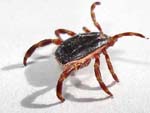|
Ticks are arachnids,
more closely related to spiders than to insects - they have eight legs. A
fully fed tick will be three to ten times larger than their unfed
counterparts.
Ticks are blood-feeding,
external parasites. They can carry disease, including, but not limited to,
Lyme disease. Ticks become active with the warm days of spring. They
generally have a multi-stage life cycle, progressing from egg to larva to
nymph to adult. Most species have different hosts for each stage. Ticks
inject saliva into their host as they feed, sometimes transmitting disease
with the saliva.
Ticks are common in areas of
long vegetation such as bracken, long grass or bilberry. Here they wait
for passing animals (including humans) to attach themselves to, feeding on
their blood before dropping off. It is more likely that your pet will pick
up ticks than you will but it is important to remember that there is a
small chance of picking up a tick and an even smaller chance of developing
Lyme disease.
Lyme disease
Whilst Lyme Disease used to be
rare with less than 100 cases a year the
Health Protection Agency
reported 900+ cases in 2007, this figure does not include unreported or
undiagnosed cases which the HPA estimate could cause between 1,000 and
2,000 additional cases per year.
Most ticks are not infected with the
bacteria that cause Lyme disease. However it is important to be aware of
the symptoms and some of the precautionary measures you can take.
- Lyme
disease is an infection that affects the skin and occasionally causes
serious illness.
- The
disease may first show itself as an expanding reddish, round rash in the
area around the bite. This rash may start three to thirty days after the
tick has bitten you.
- Early
symptoms may resemble influenza, with swollen glands near the site, mild
headaches, aching muscles and tiredness.
- If
left untreated the disease may develop over months or years into a
serious illness affecting the nervous system, joints or heart.
- The
good news is that Lyme disease is very treatable by antibiotics – so, if
you have any of these symptoms, inform your doctor.
- Note:
If any type of rash appears after a bite, do try and take a photograph
as it will help with later diagnosis.
Simple preventative measures…
-
You should
make it more difficult for a tick to reach your skin by wearing shoes
rather than sandals and tuck long trousers into socks or wear gaiters.
-
Ticks can be more easily
seen on white or light-coloured clothing.
-
Avoid a tick's favourite
places by walking in the middle of paths and check yourself after
sitting on logs or leaning against tree trunks.
-
If you picnic, use a light-coloured
picnic blanket to sit on; also check the underside of the blanket.
-
Check your pets for ticks
when they come into the house.
-
Spray your
clothing with an effective anti-tick pesticide. Make sure you follow the
instructions carefully.
After visiting an area likely
to contain ticks, do a full body inspection of yourself, your children and
any pets that were with you. Common sites of attachment include the
underarms, the groin, behind the knee and the nape of the neck. Examine
children often, paying special attention to the head, neck and ears. Early
discovery of ticks is critical to reducing the risk of infection by Lyme
disease.
If a tick is found, removal
should be done carefully to prevent its mouth parts from breaking off in
the skin.
How to remove a tick promptly
and properly:
Using tweezers, grasp the tick as close to the skin as possible and gently
pull the tick in a steady, upward motion without twisting or jerking.
NEVER USE BARE HANDS.
Wash the area with a
disinfectant.
DO NOT touch the tick with your bare hands.
DO NOT squeeze the tick.
DO NOT put alcohol, nail polish remover or Vaseline on the tick.
DO NOT use a hot match or cigarette end.
For more information please
visit
http://www.lymediseaseaction.org.uk or type ‘Lyme Disease’ into a
search engine.
|


